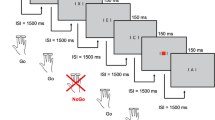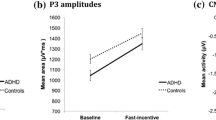Abstract
This study compares behavioral and electrophysiological (P300) responses recorded in a cued continuous performance task (CPT-AX) performed by children with attention deficit hyperactivity disorder-combined subtype (ADHD-com) and age-matched healthy controls. P300 cognitive-evoked potentials and behavioral data were recorded in eight children with ADHD (without comorbidity) and nine control children aged 8–12 years while performing a CPT-AX task. Such task enables to examine several kinds of false alarms and three different kinds of P300 responses: the “Cue P300”, the “Go P300” and the “NoGo P300”, respectively, associated with preparatory processing/attentional orienting, motor/response execution and motor/response inhibition. Whereas hit rates were about 95 % in each group, ADHD children made significantly more false alarm responses (inattention- and inhibition-related) than control children. ADHD children had a marginally smaller Cue P300 than the control children. Behavioral and electrophysiological findings both highlighted inhibition and attention deficits in ADHD-com children in the CPT-AX task. A rarely studied kind of false alarm, the “Other” FA, seems to be a sensitive FA to take into account, even if its interpretation remains unclear.




Similar content being viewed by others
References
(WHO) WHO (1993) The ICD-10 classification of mental and behavioural disorders. Geneva: World Health Organization
Association AP (2000) Diagnostic and statistical manual of mental disorders, 4th edition, text revision (DSM-IV-TR). American Psychiatric Association, Washington
Yoon HH, Iacono WG, Malone SM, Bernat EM, McGue M (2008) The effects of childhood disruptive disorder comorbidity on P3 event-related brain potentials in preadolescents with ADHD. Biol Psychol 79:329–336
Spronk M, Jonkman LM, Kemner C (2008) Response inhibition and attention processing in 5- to 7-year-old children with and without symptoms of ADHD: an ERP study. Clin Neurophysiol 119:2738–2752
Wolraich ML, Hannah JN, Pinnock TY, Baumgaertel A, Brown J (1996) Comparison of diagnostic criteria for attention-deficit hyperactivity disorder in a county-wide sample. J Am Acad Child Adolesc Psychiatry 35:319–324
Barkley RA (1997) Behavioral inhibition, sustained attention, and executive functions: constructing a unifying theory of ADHD. Psychol Bull 121:65–94
Johnstone SJ, Clarke AR (2009) Dysfunctional response preparation and inhibition during a visual Go/Nogo task in children with two subtypes of attention-deficit hyperactivity disorder. Psychiatry Res 166:223–237
Clark JM (1996) Contributions of inhibitory mechanisms to unified theory in neuroscience and psychology. Brain Cogn 30:127–152
Johnstone SJ, Dimoska A, Smith JL, Barry RJ, Pleffer CB, Chiswick D et al (2007) The development of stop-signal and Go/Nogo response inhibition in children aged 7–12 years: performance and event-related potential indices. Int J Psychophysiol 63:25–38
Carter CS, Krener P, Chaderjian M, Northcutt C, Wolfe V (1995) Abnormal processing of irrelevant information in attention deficit hyperactivity disorder. Psychiatry Res 56:59–70
van Leeuwen TH, Steinhausen HC, Overtoom CC, Pascual-Marqui RD, van’t Klooster B, Rothenberger A et al (1998) The continuous performance test revisited with neuroelectric mapping: impaired orienting in children with attention deficits. Behav Brain Res 94:97–110
Beck LH, Bransome ED Jr, Mirsky AF, Rosvold HE, Sarason I (1956) A continuous performance test of brain damage. J Consult Psychol 20:343–350
McLoughlin G (2005) Electrophysiological parameters in psychiatric research: ADHD. Psychiatry 4:14–18
Davies D, Parasuraman R (1982) The psychology of vigilance. Academic Press, London
van Leeuwen TH, Verbaten MN, Koelega HS, Slangen JL, van der Gugten J, Camfferman G (1995) Effects of oxazepam on event-related brain potentials, EEG frequency bands, and vigilance performance. Psychopharmacology 122:244–262
Warm J (1984) Sustained attention in human performance. Wiley, Chichester
Gordon M (1979) The assessment of impulsivity and mediating behaviors in hyperactive and nonhyperactive boys. J Abnorm Child Psychol 7:317–326
Halperin JM, Newcorn JH, Matier K, Sharma V, McKay KE, Schwartz S (1993) Discriminant validity of attention-deficit hyperactivity disorder. J Am Acad Child Adolesc Psychiatry 32:1038–1043
Banaschewski T, Brandeis D, Heinrich H, Albrecht B, Brunner E, Rothenberger A (2004) Questioning inhibitory control as the specific deficit of ADHD–evidence from brain electrical activity. J Neural Transm 111:841–864
Halperin JM, Wolf LE, Pascualvaca DM, Newcorn JH, Healey JM, O’Brien JD et al (1988) Differential assessment of attention and impulsivity in children. J Am Acad Child Adolesc Psychiatry 27:326–329
Crosbie J, Schachar R (2001) Deficient inhibition as a marker for familial ADHD. Am J Psychiatry 158:1884–1890
Schachar R, Mota VL, Logan GD, Tannock R, Klim P (2000) Confirmation of an inhibitory control deficit in attention-deficit/hyperactivity disorder. J Abnorm Child Psychol 28:227–235
Sonuga-Barke EJ (2002) Psychological heterogeneity in AD/HD–a dual pathway model of behaviour and cognition. Behav Brain Res 130:29–36
Castellanos FX, Sonuga-Barke EJS, Milham MP, Tannock R (2006) Characterizing cognition in ADHD: beyond executive dysfunction. Trends in Cognitive Sciences 10:117–123
Barry RJ, Johnstone SJ, Clarke AR (2003) A review of electrophysiology in attention-deficit/hyperactivity disorder: II. Event-related potentials. Clin Neurophysiol 114:184–198
Brandeis D, van Leeuwen TH, Rubia K, Vitacco D, Steger J, Pascual-Marqui RD et al (1998) Neuroelectric mapping reveals precursor of stop failures in children with attention deficits. Behav Brain Res 94:111–125
Tomberg C, Desmedt JE (1998) Human perceptual processing: inhibition of transient prefrontal-parietal 40 Hz binding at P300 onset documented in non-averaged cognitive brain potentials. Neurosci Lett 255:163–166
Johnson R Jr (1993) On the neural generators of the P300 component of the event-related potential. Psychophysiology 30:90–97
Polich J (2007) Updating P300: an integrative theory of P3a and P3b. Clin Neurophysiol 118:2128–2148
Donchin E, Miller GA, Farwell LA (1986) The endogenous components of the event-related potential–a diagnostic tool? Prog Brain Res 70:87–102
Donchin E, Coles MG (1988) Is the P300 component a manifestation of context updating ? Behav Brain Sci 11:357–427
Polich J (2003) Overview of P3a and P3b. In: Polich J (ed) Detection of change: event-related potential and fMRI findings. Kluwer, Boston, pp 83–98
Banaschewski T, Brandeis D, Heinrich H, Albrecht B, Brunner E, Rothenberger A (2003) Association of ADHD and conduct disorder–brain electrical evidence for the existence of a distinct subtype. J Child Psychol Psychiatry 44:356–376
Brandeis D, Banaschewski T, Baving L, Georgiewa P, Blanz B, Warnke A et al (2002) Multicenter P300 brain mapping of impaired attention to cues in hyperkinetic children. J Am Acad Child Adolesc Psychiatry 41:990–998
Johnstone SJ, Barry RJ (1996) Auditory event-related potentials to a two-tone discrimination paradigm in attention deficit hyperactivity disorder. Psychiatry Res 64:179–192
Jonkman LM, Kemner C, Verbaten MN, Koelega HS, Camfferman G, vd Gaag RJ et al (1997) Effects of methylphenidate on event-related potentials and performance of attention-deficit hyperactivity disorder children in auditory and visual selective attention tasks. Biol Psychiatry 41:690–702
Taylor MJ, Voros JG, Logan WJ, Malone MA (1993) Changes in event-related potentials with stimulant medication in children with attention deficit hyperactivity disorder. Biol Psychol 36:139–156
Kemner C, Verbaten MN, Koelega HS, Camfferman G, van Engeland H (1998) Are abnormal event-related potentials specific to children with ADHD? A comparison with two clinical groups. Percept Mot Skills 87:1083–1090
Jonkman LM, Lansbergen M, Stauder JE (2003) Developmental differences in behavioral and event-related brain responses associated with response preparation and inhibition in a go/nogo task. Psychophysiology 40:752–761
Jonkman LM (2006) The development of preparation, conflict monitoring and inhibition from early childhood to young adulthood: a Go/Nogo ERP study. Brain Res 1097:181–193
Falkenstein M, Hoormann J, Hohnsbein J (2002) Inhibition-related ERP components: variation with modality, age, and time-on-task. J Psychophysiol 16:167–175
Smith JL (2011) To go or not to go, that is the question: do the N2 and P3 reflect stimulus- or response-related conflict? Int J Psychophysiol 82:143–152
Enriquez-Geppert S, Konrad C, Pantev C, Huster RJ (2010) Conflict and inhibition differentially affect the N200/P300 complex in a combined go/nogo and stop-signal task. Neuroimage 51:877–887
Brown WS, Marsh JT, LaRue A (1983) Exponential electrophysiological aging: P3 latency. Electroencephalogr Clin Neurophysiol 55:277–285
Goodin DS, Squires KC, Henderson BH, Starr A (1978) Age-related variations in evoked potentials to auditory stimuli in normal human subjects. Electroencephalogr Clin Neurophysiol 44:447–458
Katsanis J, Iacono WG, McGue MK (1996) The association between P300 and age from preadolescence to early adulthood. Int J Psychophysiol 24:213–221
Mullis RJ, Holcomb PJ, Diner BC, Dykman RA (1985) The effects of aging on the P3 component of the visual event-related potential. Electroencephalogr Clin Neurophysiol 62:141–149
Picton TW, Stuss DT, Champagne SC, Nelson RF (1984) The effects of age on human event-related potentials. Psychophysiology 21:312–325
Polich J, Geisler MW (1991) P300 seasonal variation. Biol Psychol 32:173–179
Taylor MJ (1993) Maturational changes in ERPs to orthographic and phonological tasks. Electroencephalogr Clin Neurophysiol 88:494–507
Hendricks WA, Robey KW (1936) The sampling distribution of the coefficient of variation. Ann Math Statist 7:129–132
Overtoom CC, Verbaten MN, Kemner C, Kenemans JL, van Engeland H, Buitelaar JK et al (1998) Associations between event-related potentials and measures of attention and inhibition in the Continuous Performance Task in children with ADHD and normal controls. J Am Acad Child Adolesc Psychiatry 37:977–985
Miyake A, Emerson MJ, Padilla F, Ahn JC (2004) Inner speech as a retrieval aid for task goals: the effects of cue type and articulatory suppression in the random task cuing paradigm. Acta Psychol (Amst) 115:123–142
Jonkman LM, Kemner C, Verbaten MN, Koelega HS, Camfferman G, vd Gaag RJ et al (1997) Event-related potentials and performance of attention-deficit hyperactivity disorder: children and normal controls in auditory and visual selective attention tasks. Biol Psychiatry 41:595–611
Jonkman LM, Kemner C, Verbaten MN, Van Engeland H, Camfferman G, Buitelaar JK et al (2000) Attentional capacity, a probe ERP study: differences between children with attention-deficit hyperactivity disorder and normal control children and effects of methylphenidate. Psychophysiology 37:334–346
Satterfield JH, Schell AM, Nicholas T, Backs RW (1988) Topographic study of auditory event-related potentials in normal boys and boys with attention deficit disorder with hyperactivity. Psychophysiology 25:591–606
Satterfield JH, Schell AM, Nicholas TW, Satterfield BT, Freese TE (1990) Ontogeny of selective attention effects on event-related potentials in attention-deficit hyperactivity disorder and normal boys. Biol Psychiatry 28:879–903
Hooks K, Milich R, Lorch EP (1994) Sustained attention in boys with attention deficit hyperactivity disorder. J Clin Child Psychol 23:69–77
Fallgatter AJ, Ehlis AC, Seifert J, Strik WK, Scheuerpflug P, Zillessen KE et al (2004) Altered response control and anterior cingulate function in attention-deficit/hyperactivity disorder boys. Clin Neurophysiol 115:973–981
Doehnert M, Brandeis D, Imhof K, Drechsler R, Steinhausen HC (2010) Mapping attention-deficit/hyperactivity disorder from childhood to adolescence–no neurophysiologic evidence for a developmental lag of attention but some for inhibition. Biol Psychiatry 67:608–616
Doehnert M, Brandeis D, Schneider G, Drechsler R, Steinhausen HC (2012) A neurophysiological marker of impaired preparation in an 11-year follow-up study of attention-deficit/hyperactivity disorder (ADHD). J Child Psychol Psychiatry 54(3):260–270
Sergeant JA, Scholten CA (1985) On resource strategy limitations in hyperactivity: cognitive impulsivity reconsidered. J Child Psychol Psychiatry 26:97–109
Sergeant JA, Scholten CA (1985) On data limitations in hyperactivity. J Child Psychol Psychiatry 26:111–124
Acknowledgments
This work was financially supported by The Belgian Kid’s Fund to Simon Baijot. We thank Prof. Bernard Dan for his insightful comments on the manuscript. We also thank the Laboratory of Sensory and Cognitive Neurophysiology (Brugmann Hospital, Brussels) for welcoming the electrophysiological measures.
Author information
Authors and Affiliations
Corresponding author
Rights and permissions
About this article
Cite this article
Baijot, S., Deconinck, N., Slama, H. et al. Behavioral and neurophysiological study of attentional and inhibitory processes in ADHD-combined and control children. Acta Neurol Belg 113, 477–485 (2013). https://doi.org/10.1007/s13760-013-0219-1
Received:
Accepted:
Published:
Issue Date:
DOI: https://doi.org/10.1007/s13760-013-0219-1




